Shock absorbers are an integral part of a truck’s suspension system. However, finding the best shocks for trucks is not an easy feat. And like Forrest Gump’s box of chocolates, the only way of finding out how good a shock absorber is to, well, try it for yourself. But then again, not everyone can afford the pleasure of buying new shocks every 5,000 miles or so.
In this helpful article, we’ll not only talk about the best shocks for trucks. We’ll dive deeper into how a shock absorber works and why some brands are engineered to be better than most. Next, we’ll provide a list of the best shocks for 4x4 trucks, best shocks for lowered trucks, and even the best shocks for semi-trucks.
What is a shock absorber?
In order to fully comprehend how a shock absorber works, it’s important to understand the major components of a suspension system. In most vehicles (including pickup trucks and 4x4 vehicles), the suspension consists of coil springs and shock absorbers. The springs are designed to cushion the impacts of road bumps. As you drive over a pothole, the spring absorbs the impact and turns it into vibrations.
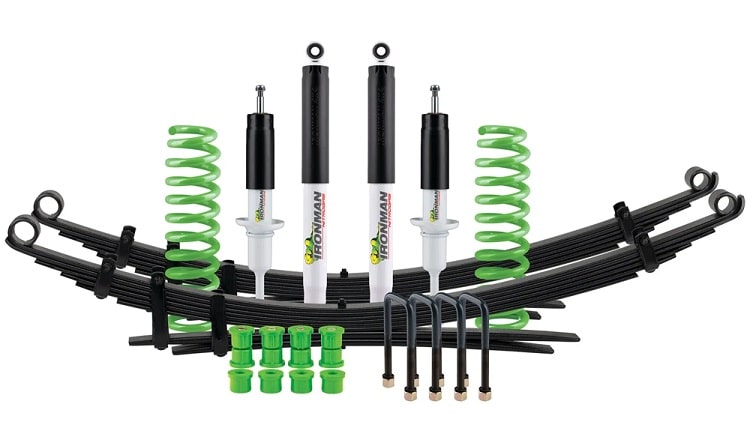
Suspension/Lift Kit
In return, the shock absorber is tuned to slow down or reduce the vibrations from the spring. Because of this, the term ‘shock absorber’ is a bit misleading. True, shock absorbers are designed to ‘absorb’ or ‘reduce’ the amount of shock felt when hitting a pothole. But on a scientific basis, shock absorbers are converting kinetic energy into thermal energy via fluid friction. Hence, shock absorbers are better known as ‘vibration dampers’ or simply ‘dampers’ in some regions of the globe.
The shock absorber contains oil, gas, or a mixture of both to absorb the heat caused by friction, which can rise from 100 to 1,200 degrees C. The efficiency or ride comfort of a shock absorber is determined by the valve passages and the flow of oil as the damper is compressed.
How does a shock absorber work?
There are two general types of shock absorbers for trucks: hydraulic (oil) and gas type (or gas pressure). Older vehicles are equipped with hydraulic shocks from the factory. Hydraulic shocks are cheaper and are good for normal driving. But since the hydraulic oil contains 10-percent air in most cases, hydraulic shocks have a higher risk of cavitation or foaming under heavy loads. This leads to a loss in damping force, which also means a bumpy ride and unsafe handling.
On the other hand, gas pressure shocks are costlier but are many times better in terms of performance, handling, and long-term ride comfort. The best gas shocks for trucks are filled with nitrogen to ensure high fluid pressures under heavy loads. This ensures the shocks are resistant to foaming or cavitation with virtually zero losses in damping force.
How do I choose shocks for my truck?
This is the hard part since there are many types of shock absorbers for trucks. If your off-roader likes crawling over rock formations, the shock absorber for that type of vehicle is different when frequently driving over sand dunes. Here are a few of the many types of shocks for trucks and 4x4 vehicles:
- Twin-tube hydraulic shocks. In some cases, hydraulic shocks have a ‘softer’ and more compliant ride, but only if the shocks are not overheating. This makes twin-tube hydraulic shocks a good choice for street or highway driving. It’s also an inexpensive option for infrequent off-roaders.
- Twin-tube gas-charged shocks. Better than ordinary hydraulic shocks and offers faster rebound for better handling. However, gas-charged twin-tube shocks may leak over time and are difficult to install without dropping the axle.
- Monotube gas-charged shocks. If you like off-roading or performance driving, monotube gas shocks are a better option if not for the higher cost. Monotube shocks offer better heat dissipation and are stronger than twin-tube shocks due to having a larger piston design.
- Reservoir shock absorbers. Most shocks with extra fluid reservoirs are designed for extreme performance driving. Equipped with an external oil reservoir, it provides consistent damping rates even during repeated high loads. But then again, reservoir shocks are one of the most expensive options.
- Coilover suspension. Adjustable coilovers are an excellent option if you’re looking for a set of shocks with adjustable damping and ride height. If you do a lot of towing or cargo carrying in your truck, coilovers offer better support and stable handling. However, it comes at a cost since coilovers are also more expensive.
Which is better: gas or oil shocks?
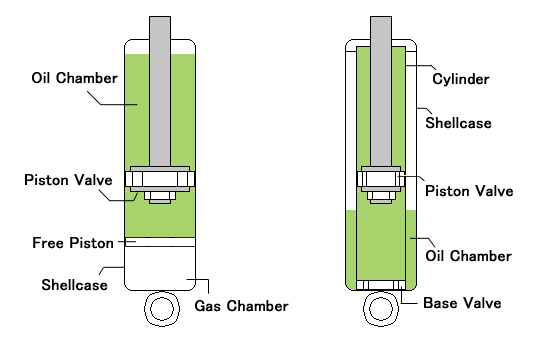
In general, gas shocks are better in terms of durability, ride comfort, and handling. In some applications, hydraulic shocks have a softer ride in exchange for floaty handling. However, gas shocks are costlier than oil shocks, so the answer really depends on what you’re looking for in a set of shock absorbers.
The Best Shocks for Trucks
Bilstein B6 4600
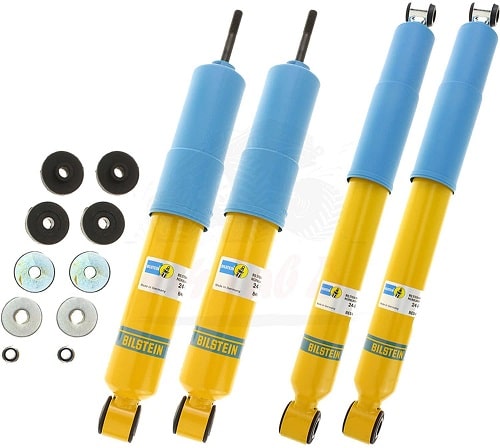
The Bilstein B6 4600 series is the best gas-pressure monotube shock absorber for on and off-road driving. Featuring a seamless monotube design offering maximum heat dissipation, these shocks can be installed upside down. Equipped with digressive valving that reacts instantly to changing road conditions, the Bilstein B6 4600 is engineered to offer maximum comfort and traction over a variety of surfaces.
Best of all, you don’t need to change the stock springs when upgrading to a better set of Bilstein 4600 dampers. Whether you have an import or domestic truck, the Bilstein 4600 will significantly improve stability and handling with a basic install.
Pro Comp 2 Adjustable Struts and Monotube Rear Shocks
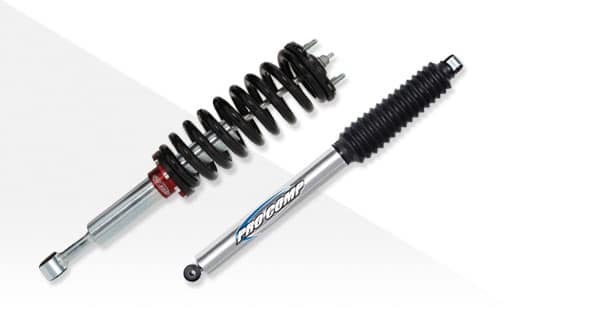
If you have a late model import/domestic truck, the Pro Comp 2 suspension kit is worthy of consideration. The kit includes a pair of Front Pro Runner adjustable struts for the front and a pair of Pro runner monotube shocks for the rear of your truck. The front struts are equipped with a height-adjustable collar, making it easy to raise or lower the front of your rig by up to 1.75 inches.
Meanwhile, the Pro Runner rear shocks have a monotube design to offer better stability under extreme applications. This kit is like having coilovers in the front without paying an exorbitant price tag.
Monroe Reflex Shock Absorber
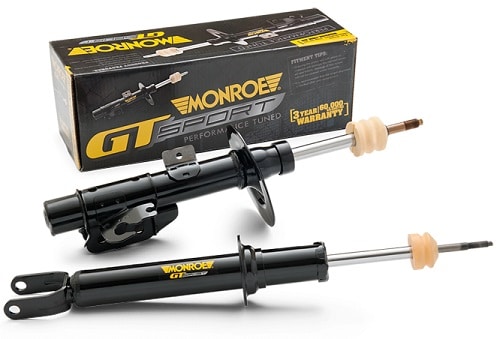
Looking for an upgrade over the OEM shocks in your rig? The Monroe Reflex is perfect for light trucks and SUVs. It offers excellent load-carrying capabilities while offering a comfortable ride. Featuring Monroe’s unique Hydraulic Lockout technology that isolates the impact of suspension travel, the all-weather fluid with friction modifiers ensures steady handling with great ride comfort.
The Monroe Reflex Shock Absorber is constructed using high-pressure nitrogen gas. This allows the shock absorber to deliver quick responses to compression and rebound for better control.
Best Shocks for Lifted Trucks
Bilstein 5100 Series
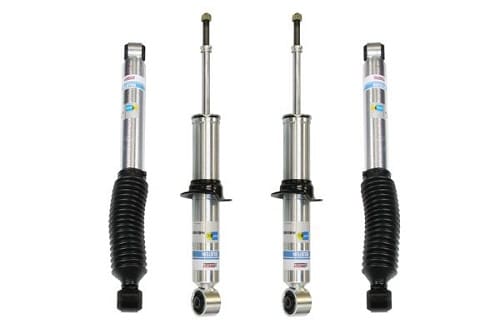
The Bilstein 5100 Series is the best shocks for lifted trucks. Specifically designed and engineered for lifted trucks with modified suspension, the Bilstein 5100 Series has the same set of features that make Bilstein shocks the best in the world. For starters, lifted vehicles with larger tires need a specific set of shocks to address the change in suspension geometry. The 5100 Series features a monotube design with digressive valving to offer unparalleled stability and better ride comfort.
The Bilstein 5100 Series is ideal for light trucks and SUVs. Best of all, it offers superior performance whether on or off-road due to Bilstein’s gas-pressure technology.
Bilstein B8 5100 Ride Height Adjustable
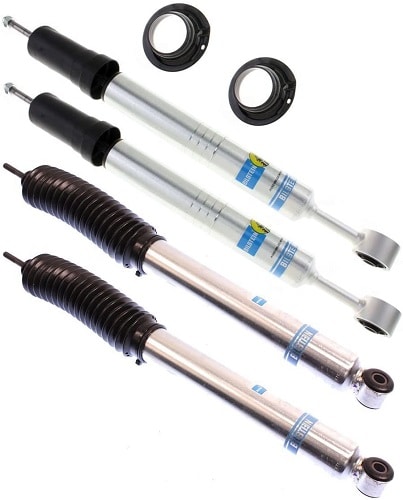
Bilstein has a bevy of shock absorbers for light trucks and SUVs. The B8 5100 Ride Height Adjustable series is ideal for semi-lifted trucks with up to 1” of lift. This kit includes a set of height-adjustable front shocks with an adjustable spring perch. While the included monotube rear shocks can accommodate up to 1” of lift, the front shocks are adjustable up to 2.75-inches.
This kit is a nice and affordable alternative to coil spacers after installing a lift kit. Featuring an extra-large 46 mm monotube design, Bilstein shocks are renowned to offer fade-free performance and a comfortable ride under the most demanding conditions.
KYB MonoMax Gas Shock

The KYB MonoMax Gas Shock is engineered to deliver extreme performance. It offers up to 40-percent better damping than the factory shocks in your truck. Featuring a monotube design for better heat dissipation, the zinc-coated stainless steel piston ring offers a tight seal under the most demanding off-road conditions. The result is better stability, steady handling, incredible traction, and a comfortable ride.
In fact, the MonoMax monotube shock absorber is the most durable that KYB has ever created. And while this shock absorber is best for lifted trucks, it’s also good for frequent towing or carrying heavy loads.
Best Shocks for Lowered Trucks
Rancho RS9000XL Gas Charged
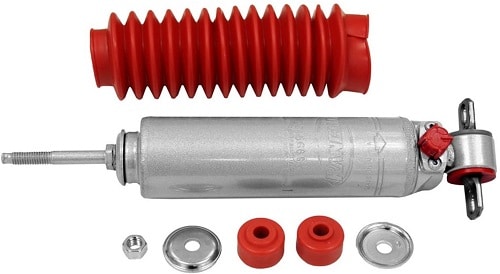
If you’re looking for an adjustable set of shock absorbers, take a closer look at the Rancho RS9000XL. Featuring Ranchos My Ride 9-position damping system, this kit is also the best shocks for lowered trucks. With a nitrogen-charged construction and chrome piston rod, these heavy-duty adjustable shock absorbers are great for on and off-road applications.
Unlike other lesser-endowed performance shocks, the Rancho RS9000XL has a 2.75-inch body diameter that holds more hydraulic fluid. It also comes with a limited lifetime warranty.
Belltech 8000 Nitro Drop Shock Absorbers
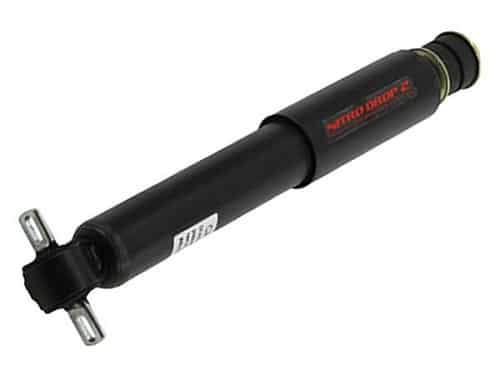
If you have an American or import truck with lowered suspension, check out the Belltech 8000 Nitro Drop Shock Absorbers. It offers OEM ride quality despite a 5 to 7-inch suspension drop. Equipped with a cavitation-free valve train, it also offers better handling and stability.
Belltech 8000 Nitro Drop shocks are equipped with OEM quality rubber mounts and are made specifically for a wide array of Ford, Chevy, Lincoln, Ram, Mazda, and Toyota trucks.
Best Shocks for Towing and Carrying Heavy Loads
Monroe Load Adjusting Shock Absorber

This set of Monroe Load Adjusting Shock Absorbers are great for light trucks that carry varying loads. It’s also ideal for trucks and SUVs that do a lot of towing regularly. Monroe’s load-adjusting shocks can maintain the ride height of your vehicle even when loaded with up to 1,100 lbs. of additional weight.
This is made possible by an all-weather fluid with friction modifiers to offer reliable damping. The shocks also come with full-displaced valving to offer a more consistent ride quality than ordinary shock absorbers.
Gabriel Hijackers Air Shocks
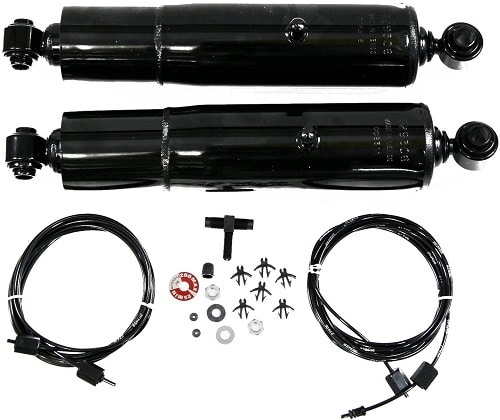
Gabriel Hijackers are the best-known air-adjustable shock absorbers in America. Constructed with a leak-proof piston seal, a super-finished chrome piston rod, and drawn-over mandrel tubing, this shock absorber is great for towing or short-term heavy loads.
According to Gabriel, Hijackers provide up to 1,100 pounds of extra lifting capacity per pair. It reduces the risk of bottoming out while improving the handling and ride quality of your truck. It takes the sag out while reducing vehicle sway for safer towing.
Frequently Asked Questions (FAQs)
Who makes the best shocks for trucks?
In our experience, Bilstein makes the best shocks for trucks or any vehicle. Bilstein’s monotube gas-pressure shock absorbers were the first in series-production gas-charged shocks and have over 60 years of experience in the automotive industry. Bilstein shocks are also renowned in the motorsports arena and continue to lead the field in suspension and damping technology.
Do shocks make the ride smoother?
In general, yes. Shock absorbers are designed to deliver a better and smoother ride, but it depends on the application. For instance, adjustable shocks can either firm up or soften the ride comfort. Basically, a comfortable ride depends on the ratio between the unsprung and sprung mass of your rig. If the unsprung mass ratio is smaller than the sprung mass, you can expect better ride comfort.
What shocks give the smoothest ride?
In all fairness, hydraulic shocks are renowned to offer a more cushioned ride than a new set of gas-charged shocks. However, it also depends on the type of shocks. Performance shock absorbers are more oriented towards handling than ride comfort, while adjustable shocks have variable damping characteristics. In our tests, the Bilstein B6 4600 and Monroe Reflex are among the best shock absorbers in terms of ride quality.
When should you replace shocks on a truck?
It depends on your driving patterns. Generally speaking, shocks and struts should be inspected and replaced every 50,000 to 100,000 miles under normal driving conditions. But if you have a work truck or if you fancy off-roading, you may need to inspect and replace the shocks more frequently.
But there are warning signs to consider. If you notice the following symptoms in your truck, it may be time to replace the shock absorbers:
- The truck sways or leans when changing lanes
- Excessive bouncing when riding over bumps and uneven pavement
- Unstable braking performance
- Stiffer steering feel
- Poor steering response
- Clanking noise when going over ruts and bumps
- Iffy handling
- Fluid leaks on the shock body
- Unusual or uneven tire wear
- Bumpier ride
Do I need an alignment after replacing the rear shocks in my truck?
The general rule is changing the wheels, tires, and shocks will not require an alignment, especially in the rear of your truck. However, changing the control arms, ball joints, and tie rod ends will require an alignment.
If your truck is relatively old or it’s been years since the last alignment, it’s a good idea to at least have the alignment checked after replacing the shock absorbers in both the front and rear of your truck. The same holds true after installing a lift or lowering kit.
How do you tell if your shocks are bad on a truck?
One of the most noticeable symptoms of a bad shock absorber is a bouncy ride. Check for oil or fluid leaks on the shock body. If you see leaks on the shock, it needs to be replaced. You can also perform the bounce test by pushing down one corner of your rig. If the body bounces up and down more than two times after being pushed, your truck may need a new set of shocks.
Can I replace one shock absorber only?
You can, but it doesn’t mean that you should. When replacing the front and/or rear shocks, it’s better to replace it as a pair. Using a mixture of old and new shocks from different makes and brands will result in poor handling and a distorted ride. In our opinion, it’s always best to replace both front and rear shocks as a pair – and it’s much better if you can afford to replace all four shock absorbers at the same time.
Are expensive shocks worth it?
Yes. When buying new shocks for your truck, the price is a solid indication of build-quality and performance. However, it also depends on the brand. More than just looking at the price, we also go for brands that offer a good warranty. But when it comes to off-road suspension parts, expensive shocks are superior in all aspects including quality, on and off-road performance, durability, and ride comfort.